
Transport in Macau includes road, sea, rail and air transport. Road transport is the primary mode of transport within Macau, although a new rail system opened in December 2019 serving the areas of Taipa and Cotai. The main forms of public transport are buses and taxis.

Shenzhen is a city in the province of Guangdong, China. A special economic zone, it is located on the east bank of the Pearl River estuary on the central coast of Guangdong, bordering Hong Kong to the south, Dongguan to the north, Huizhou to the northeast, and Macau to the southwest. With a population of 17.5 million in 2020, Shenzhen is the third most populous city by urban population in China after Shanghai and Beijing. The Port of Shenzhen is the world's fourth busiest container port.

The Hong Kong–Zhuhai–Macau Bridge (HZMB) is a 55-kilometre (34 mi) bridge–tunnel system consisting of a series of three cable-stayed bridges, an undersea tunnel, and four artificial islands. It is both the longest sea crossing and the longest open-sea fixed link in the world. The HZMB spans the Lingding and Jiuzhou channels, connecting Hong Kong and Macau with Zhuhai—a major city on the Pearl River Delta in China.
Lo Wu is an area in North District, New Territories, Hong Kong. It lies on the border between Hong Kong and mainland China, specifically the Luohu District of Shenzhen in mainland China. The area is most notable as the location of the most heavily used immigration control point for passengers travelling to and from mainland China. It is where the Lo Wu station is located.

Luohu District is a district of Shenzhen, China, located north of the New Territories of Hong Kong, east of Futian District, southeast of Longgang District, southwest of Pingshan District, and west of Yantian District. It is one of the oldest parts of the city, having represented Shenzhen as a fishing village before 1953 and a market town from 1953 to 1979, when Bao'an County was promoted to a prefecture-level city and renamed Shenzhen.

The Sham Chun River or Shenzhen River serves as the natural border between Hong Kong and Mainland China, together with Deep Bay, Mirs Bay, and the Sha Tau Kok River.
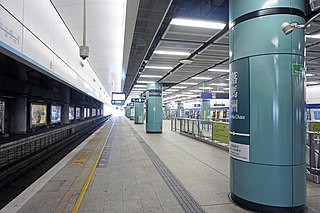
Lok Ma Chau is the northwestern terminus in Lok Ma Chau on the Lok Ma Chau Spur Line, a branch line of the East Rail line of Hong Kong's MTR network, which was built to alleviate the immigration checkpoint between Hong Kong and mainland China's Shenzhen at Lo Wu station. MTR Corporation promotes use of Lok Ma Chau as a direct connection with Line 4 and alongside Line 10 of the Shenzhen Metro, the former which is also operated by the MTR Corporation.

Deep Bay is a bay between Yuen Long District, in the New Territories, Hong Kong and the city of Shenzhen in Guangdong Province. It is otherwise known as Hau Hoi Wan in Hong Kong, and Shenzhen Bay in Mainland China.

Huanggang Port is a port of entry on the border between mainland China and Hong Kong, in the Futian District of Shenzhen, Guangdong. Its counterpart in Hong Kong is the Lok Ma Chau Control Point, located in Lok Ma Chau in Hong Kong's New Territories, across the Sham Chun River from Huanggang.
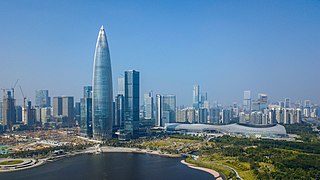
Nanshan District is one of the nine districts comprising Shenzhen. It encompasses the southwest area of the Shenzhen Special Economic Zone, with a population of 1.08 million. In 2022, the district of Nanshan's local GDP output exceeded 800 billion Chinese Yuan or 111 billion U.S. dollars, an economy slightly larger than that of Cuba or Oman. The region has an established tourism industry and is home to several sightseeing locations, as well as multiple seaside parks such as the Shenzhen Bay Park and the Shenzhen Talent Park. Its tallest building is the 393-meter China Resources Headquarters.

The Hong Kong–Shenzhen Western Corridor, also known for the main component Shenzhen Bay Bridge, is a cross-border highway between Shenzhen, Guangdong Province and Hong Kong. The highway bridge is a 5.5-kilometre (3.4 mi) dual three-lane controlled-access highway. It connects Ngau Hom Shek, Hong Kong, to Dongjiaotou, which is administratively located in Nanshan District of Shenzhen. The corridor also had other components, a border checkpoint Shenzhen Bay Port, built on reclaimed land, as well as roads that connect the corridor to the existing road network of Shenzhen.

Lok Ma Chau Control Point is an immigration control point in Lok Ma Chau, Yuen Long District, New Territories, Hong Kong, which is on the border between Hong Kong and mainland China. It opened in 1989 as the third road crossing between the then British dependent territory and China. It started providing 24-hour passenger clearance in January 2003, and is still the only Hong Kong control point with Shenzhen in mainland China to do so. Its counterpart is the Huanggang Port in mainland China, across Sham Chun River and interconnected by the Lok Ma Chau Bridge.
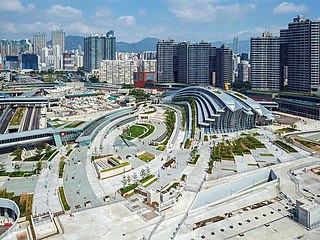
Hong Kong West Kowloon station is the southern terminus of and the only station on the Hong Kong section of the Guangshengang XRL. The station connects to China's high-speed rail (HSR) network across the border through dedicated tunnels and includes a Mainland Port Area where the laws of (Mainland) China are enforced. It was constructed by the MTR Corporation Limited as the project manager commissioned by the Hong Kong Government, through subcontractors.

The Gongbei Port is an immigration and customs checkpoint located in Zhuhai in mainland China, on its border with Macau. It is operated by the Bureau of Exit and Entry Administration of the Ministry of Public Security, and the General Administration of Customs.
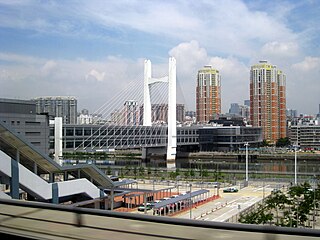
Futian Port or the Lok Ma Chau Spur Line Control Point is an immigration port of entry/border crossing on the border between mainland China and Hong Kong, located in the Futian District of Shenzhen in mainland China.

The Luohu Port is a port of entry/border crossing between mainland China and Hong Kong, located in Luohu District of Shenzhen and Lo Wu, New Territories of Hong Kong. It sits within the Frontier Closed Area. The control point is integrated with Lo Wu station of the Mass Transit Railway (MTR) and Luohu station of the Shenzhen metro, the Hong Kong counterpart being Lo Wu Control Point.
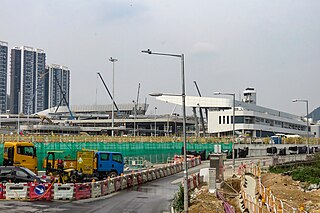
Heung Yuen Wai Control Point is a land border control point at the border at Heung Yuen Wai in North District, New Territories, Hong Kong. Its counterpart across the border is Liantang Port in Shenzhen, Guangdong. The control point opened for freight trucks on 26 August 2020 and to passengers since 6 February 2023.

Hong Kong–Shenzhen Western Express Railway is a proposed cross-border railway offering three future distinct services, direct connection between Hong Kong International Airport (HKIA) and Shenzhen Bao'an International Airport; cross-border service between Hung Shui Kiu and Qianhai; and domestic service between Tuen Mun and Siu Ho Wan.

Shekou is an area at the southern tip of Nanshan District, Shenzhen, Guangdong Province, China. It faces Yuen Long, Hong Kong across the Shenzhen Bay. It has been designated as a Free Trade Zone by the government, alongside Qianhai, Hengqin and Nansha New Area.

Heung Yuen Wai Highway, also abbreviated as HYWH, is a controlled-access highway in North District, New Territories, Hong Kong. It diverges from Fanling Highway of Route 9 at Kau Lung Hang, crosses Sha Tau Kok Road and connects to Heung Yuen Wai Control Point, a border checkpoint between Hong Kong and China which opened for freight traffic on 26 August 2020.






















